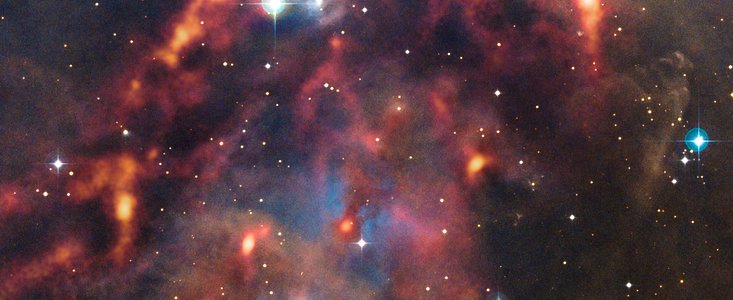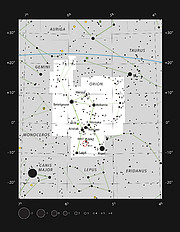Persbericht
Duisternis tot gloeien gebracht
23 januari 2013
Een nieuwe opname van het Atacama Pathfinder Experiment (APEX) in Chili geeft een schitterend beeld van kosmische stofwolken in het sterrenbeeld Orion. Terwijl deze dichte interstellaire wolken op zichtbare golflengten donker en allesverhullend lijken, kan de LABOCA-camera van de APEX-telescoop de warmtegloed van het stof detecteren en de schuilplaatsen van sterren-in-wording zichtbaar maken. Maar één van deze donkere wolken is niet wat het lijkt.
Dichte wolken van kosmisch gas en stof zijn de kraamkamers van sterren. Op zichtbare golflengten is het stof donker genoeg om achtergrondsterren te verdonkeremanen. Zodanig zelfs dat, toen astronoom William Herschel in 1774 zo’n wolk in het sterrenbeeld Schorpioen waarnam, hij deze aanzag voor een gebied zonder sterren en schijnt te hebben uitgeroepen: ‘Hier ist wahrhaftig ein Loch im Himmel!’ [1]
Om de vorming van sterren beter te leren begrijpen, hebben astronomen telescopen nodig die op langere golflengten kunnen waarnemen – in het submillimetergebied bijvoorbeeld, waar de donkere stofdeeltjes juist licht uitstralen in plaats van absorberen. APEX, op de Chajnantor-hoogvlakte in de Chileense Andes, is de grootste enkelvoudige submillimeter-telescoop op het zuidelijk halfrond en ideaal voor het onderzoek van de geboorte van sterren.
Het Orioncomplex, dat op een afstand van ongeveer 1500 lichtjaar in het sterrenbeeld Orion staat, is het meest nabije grote stervormingsgebied. Het omvat een schat aan heldere nevels, donkere wolken en jonge sterren. De nieuwe opname toont een deel van dit uitgestrekte complex op zichtbare golflengten met daaroverheen, in heldere oranje tinten, de APEX-waarnemingen, die de donkere wolken tot gloeien lijken te brengen. Op veel plaatsen valt de APEX-gloed samen met een donkere plek op de achtergrondopname – een duidelijke aanwijzing dat het gaat om een dichte stofwolk die zichtbaar licht absorbeert, maar op submillimeter-golflengten gloeit en dus wellicht sterren-in-wording bevat.
De heldere plek onder het midden van de opname is de nevel NGC 1999. Op zichtbare golflengten is dit een zogeheten reflectienevel: een diffuse stofnevel die het lichtblauwe licht van achtergrondsterren weerkaatst. De nevel wordt voornamelijk aangelicht door de intense straling van de jonge ster V380 Orionis [2], die zich in zijn hart verschuilt. In het centrum van de nevel bevindt zich een donkere plek die op een bekende opname van de Hubble-ruimtetelescoop van NASA en ESA nog duidelijker te zien is.
Doorgaans wijst zo’n donkere plek op het bestaan van een dichte wolk van kosmisch stof, die de sterren en nevels erachter aan het zicht onttrekt. Maar uit deze nieuwe opname blijkt dat de plek, ondanks de bijdrage van APEX, opvallend donker blijft. Hieruit leiden astronomen af dat dit een gat of holte in de nevel is, die door materiaal afkomstig van de ster V380 Orionis is ‘uitgegraven’. Er is in dit geval dus bijna letterlijk sprake van een gat in de hemel!
Het gebied op deze opname bevindt zich ongeveer twee graden ten zuiden van de grote en overbekende Orionnevel (Messier 42), die bovenaan de overzichtsfoto van de Digitized Sky Survey te zien is.
De APEX-waarnemingen die voor deze opname zijn gebruikt, stonden onder leiding van Thomas Stanke (ESO), Tom Megeath (Universiteit van Toledo, VS) en Amy Stutz (Max-Planck-Institut für Astronomie, Heidelberg, Duitsland).
Noten
[1] ‘Er is hier werkelijk een gat in de hemel!’
[2] V380 Orionis heeft een oppervlaktetemperatuur van ongeveer 10.000 kelvin (ongeveer gelijk aan 10.000 graden Celsius) en is daarmee bijna twee keer zo heet als onze zon. Zijn massa bedraagt naar schatting 3,5 zonsmassa.
Meer informatie
ESO is de belangrijkste intergouvernementele astronomische organisatie in Europa en de meest productieve sterrenwacht ter wereld. Zij wordt ondersteund door vijftien landen: België, Brazilië, Denemarken, Duitsland, Finland, Frankrijk, Italië, Nederland, Oostenrijk, Portugal, Spanje, Tsjechië, het Verenigd Koninkrijk, Zweden en Zwitserland. ESO voert een ambitieus programma uit, gericht op het ontwerpen, bouwen en beheren van grote sterrenwachten die astronomen in staat stellen om belangrijke wetenschappelijke ontdekkingen te doen. Ook speelt ESO een leidende rol bij het bevorderen en organiseren van samenwerking op astronomisch gebied. ESO beheert drie waarnemingslocaties van wereldklasse in Chili: La Silla, Paranal en Chajnantor. Op Paranal staan ESO’s Very Large Telescope (VLT), de meest geavanceerde optische sterrenwacht ter wereld, en twee surveytelescopen: VISTA werkt in het infrarood en is de grootste surveytelescoop ter wereld en de VLT Survey Telescope is de grootste telescoop die uitsluitend is ontworpen om de hemel in zichtbaar licht in kaart te brengen. ESO is ook de Europese partner van de revolutionaire telescoop ALMA, het grootste astronomische project van dit moment. Daarnaast bereidt ESO momenteel de bouw voor van de 39-meter Europese Extremely Large optical/near-infrared Telescope (E-ELT), die ‘het grootste oog op de hemel’ ter wereld zal worden.
Links
- Het hierboven genoemde onderzoek van de donkere plek in NGC 1999 staat beschreven in een artikel van T. Stanke et al, A&A 518, L94 (2010), ook verkrijgbaar als preprint.
Contact
Thomas Stanke
ESO
Garching, Germany
Tel: +49 89 3200 6116
E-mail: tstanke@eso.org
Douglas Pierce-Price
ESO ALMA/APEX Public Information Officer
Garching, Germany
Tel: +49 89 3200 6759
E-mail: dpiercep@eso.org
Rodrigo Alvarez (press contact België)
ESO Science Outreach Network
en Planetarium, Royal Observatory of Belgium
Tel: +32-2-474 70 50
E-mail: eson-belgië@eso.org
Over dit bericht
| Persberichten nr.: | eso1304nl-be |
| Naam: | NGC 1999 |
| Type: | Milky Way : Nebula : Type : Star Formation |
| Facility: | Atacama Pathfinder Experiment |
| Instruments: | LABOCA |
| Science data: | 2010A&A...518L..94S |
Our use of Cookies
We use cookies that are essential for accessing our websites and using our services. We also use cookies to analyse, measure and improve our websites’ performance, to enable content sharing via social media and to display media content hosted on third-party platforms.
ESO Cookies Policy
The European Organisation for Astronomical Research in the Southern Hemisphere (ESO) is the pre-eminent intergovernmental science and technology organisation in astronomy. It carries out an ambitious programme focused on the design, construction and operation of powerful ground-based observing facilities for astronomy.
This Cookies Policy is intended to provide clarity by outlining the cookies used on the ESO public websites, their functions, the options you have for controlling them, and the ways you can contact us for additional details.
What are cookies?
Cookies are small pieces of data stored on your device by websites you visit. They serve various purposes, such as remembering login credentials and preferences and enhance your browsing experience.
Categories of cookies we use
Essential cookies (always active): These cookies are strictly necessary for the proper functioning of our website. Without these cookies, the website cannot operate correctly, and certain services, such as logging in or accessing secure areas, may not be available; because they are essential for the website’s operation, they cannot be disabled.
Functional Cookies: These cookies enhance your browsing experience by enabling additional features and personalization, such as remembering your preferences and settings. While not strictly necessary for the website to function, they improve usability and convenience; these cookies are only placed if you provide your consent.
Analytics cookies: These cookies collect information about how visitors interact with our website, such as which pages are visited most often and how users navigate the site. This data helps us improve website performance, optimize content, and enhance the user experience; these cookies are only placed if you provide your consent. We use the following analytics cookies.
Matomo Cookies:
This website uses Matomo (formerly Piwik), an open source software which enables the statistical analysis of website visits. Matomo uses cookies (text files) which are saved on your computer and which allow us to analyze how you use our website. The website user information generated by the cookies will only be saved on the servers of our IT Department. We use this information to analyze www.eso.org visits and to prepare reports on website activities. These data will not be disclosed to third parties.
On behalf of ESO, Matomo will use this information for the purpose of evaluating your use of the website, compiling reports on website activity and providing other services relating to website activity and internet usage.
Matomo cookies settings:
Additional Third-party cookies on ESO websites: some of our pages display content from external providers, e.g. YouTube.
Such third-party services are outside of ESO control and may, at any time, change their terms of service, use of cookies, etc.
YouTube: Some videos on the ESO website are embedded from ESO’s official YouTube channel. We have enabled YouTube’s privacy-enhanced mode, meaning that no cookies are set unless the user actively clicks on the video to play it. Additionally, in this mode, YouTube does not store any personally identifiable cookie data for embedded video playbacks. For more details, please refer to YouTube’s embedding videos information page.
Cookies can also be classified based on the following elements.
Regarding the domain, there are:
- First-party cookies, set by the website you are currently visiting. They are stored by the same domain that you are browsing and are used to enhance your experience on that site;
- Third-party cookies, set by a domain other than the one you are currently visiting.
As for their duration, cookies can be:
- Browser-session cookies, which are deleted when the user closes the browser;
- Stored cookies, which stay on the user's device for a predetermined period of time.
How to manage cookies
Cookie settings: You can modify your cookie choices for the ESO webpages at any time by clicking on the link Cookie settings at the bottom of any page.
In your browser: If you wish to delete cookies or instruct your browser to delete or block cookies by default, please visit the help pages of your browser:
Please be aware that if you delete or decline cookies, certain functionalities of our website may be not be available and your browsing experience may be affected.
You can set most browsers to prevent any cookies being placed on your device, but you may then have to manually adjust some preferences every time you visit a site/page. And some services and functionalities may not work properly at all (e.g. profile logging-in, shop check out).
Updates to the ESO Cookies Policy
The ESO Cookies Policy may be subject to future updates, which will be made available on this page.
Additional information
For any queries related to cookies, please contact: pdprATesoDOTorg.
As ESO public webpages are managed by our Department of Communication, your questions will be dealt with the support of the said Department.






